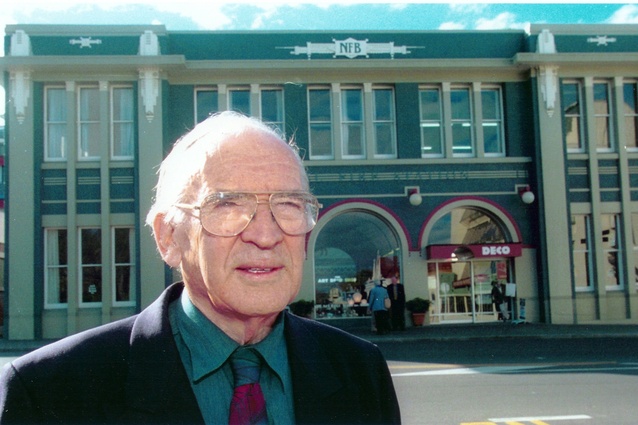Obituary: Guy Kingdon Natusch
Architect Claire Natusch remembers her great-uncle: a Hawkes Bay architect of "honest, elegantly practical" homes and a champion of heritage architecture.
I have lost count of the times someone has approached me at an architectural event and ask if I’m related to Guy Natusch. This is invariably followed by their admiration for him and his work, whether it be his tireless campaigning for our architectural heritage, someone who grew up in a house he designed, or a student of his prefabrication innovations.
It’s not surprising that he had an impact on so many people; Guy was a natural teacher, open and generous with his knowledge. He had perhaps the greatest impact on Tim Judd and Neil Fenwick who started with Guy as interns and later became his business partners. They described his mentorship as supportive; someone who despite his perfectionism gave them the creative freedom to explore their own ideas and styles.
Well into his 80s, Guy would be cheerfully giving tours of Napier, regaling us with histories embedded in the stone facades and pointing out features that had missed our attention. He would frequently describe to me how to design structures to stay upright in an earthquake, the importance of which was ingrained from an early age: Guy was just 10 years old when Napier was reduced to rubble. He recalled standing outside his school watching as the pavement buckled around him.
Born in Havelock North, Guy’s father worked alongside his brothers in the family architecture and quantity surveying firm ‘Natusch & Sons’. His grandfather C.T Natusch founded it in 1886 and became well known for his stately, arts-and-crafts-style timbered mansions. Guy appreciated the history of the family firm but when it came to his turn, he was determined to test new ground. After a decorated service in the Royal Navy, he finished his architecture degree in Auckland before returning to the Hawkes Bay to settle with his wife Joan and raise their three boys Barry, Graham and Adrian. He designed houses around the region and holiday homes further afield. More than one architect has told me that they grew up in a house designed by Guy and that it had an influence on their decision to make architecture their career.
These houses were honest, elegantly practical in their construction and of a modest scale. Qualities that many of us also associate with his contemporaries, the Group Architects. He would pay particular attention to the site whether it be framing views or opening the house to the easy Hawkes Bay climate. His Bisson House was described at the time as fostering: “an easy, unhampered home life, closely related to the outdoors”
This simplicity was not initially appreciated by all. Guy recalled builders baulking at taking on designs so unconventional. Yet he was determined to advance the way we built and lived. In the early 1950’s he started a low-cost prefabricated housing project called Solwood. The houses were to be affordable through simple, clean design and construction. Ahead of its time, it never really took off, but modern house construction in New Zealand owes a lot to the trailblazers like Guy. Prefabrication was also used in his family bach at Lake Rotoiti. It’s a lovely little structure built over many summers.
I get the sense that Guy was most widely known for his tireless crusade to ensure the preservation of our architectural heritage, and I do mean tireless. Despite turning 99 this year he was still battling the council to ensure that the Napier’s War Memorial was retained as a war memorial rather than being converted into a convention centre. He was successful. Lest we forget.
His approach to these issues was polite, determined and to the point. At Guy’s funeral, Napier’s mayor, Kirsten Wise, who had been on the receiving end of his efforts with the War Memorial gave a tribute where she described him as ‘an absolute gentleman’. Guy championed heritage architects, passionately believing they should be allowed to assess architectural merit for future generations. Napier is now a shining example of how we can collectively change our mind about what is worth keeping, to cherish what was previously unfashionable.
Guy fought for many of Napier’s gems when the demolition ball was looming: the former Criterion Building, the AMP Building and the former BNZ building. He remained active as an advisor to Heritage New Zealand well into his retirement, a role that he began in the late 1960s. In the 2003 New Year Honours, he was appointed a Member of the New Zealand Order of Merit, for services to architecture.
For all his efforts to save others’ buildings, the fate of two of Guy’s own masterpieces were lost to ‘progress’. The Wool Exchange was designed in 1962 and demolished less than 10 years later to make way for Te Pania Hotel. The Exchange was an eye-catching design formed around its tiered seating within. And, the aforementioned waterfront Napier War Memorial has lost its sinuous simplicity through extensive alterations.
However, if you visit Napier, you’ll find a little gem of his still standing on Tennyson Street; solid like its Art Deco neighbours but with a starkly modernist attitude. The Red Cross building is easily identifiable by the grid of deeply recessed square windows, lined with gleaming maroon tiles. Stand back and squint and you see the façade as a series of white crosses, a clever reversal of the red cross insignia. It was unlike anything seen in New Zealand when Guy designed it in 1952; a radical start to an impressive architectural career.











